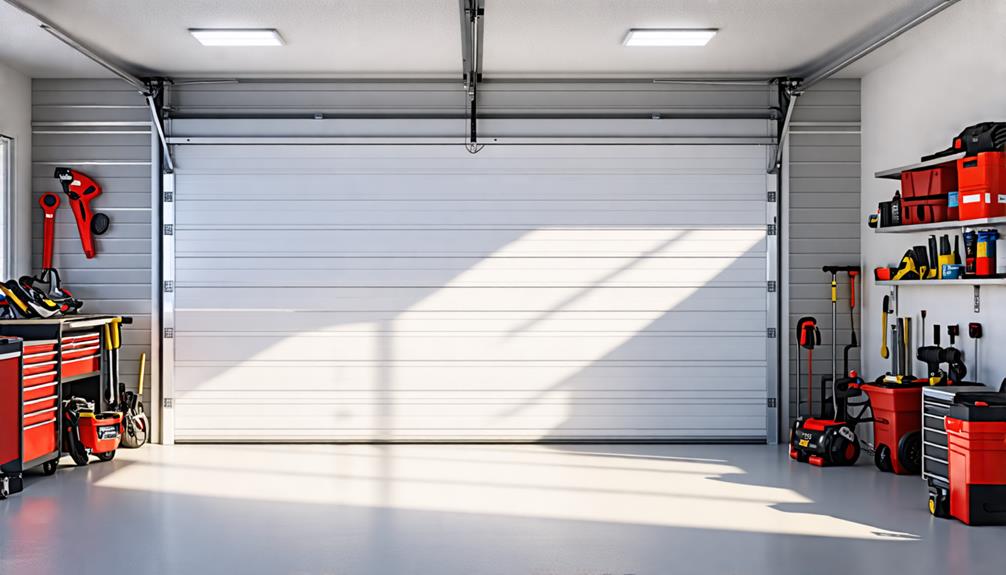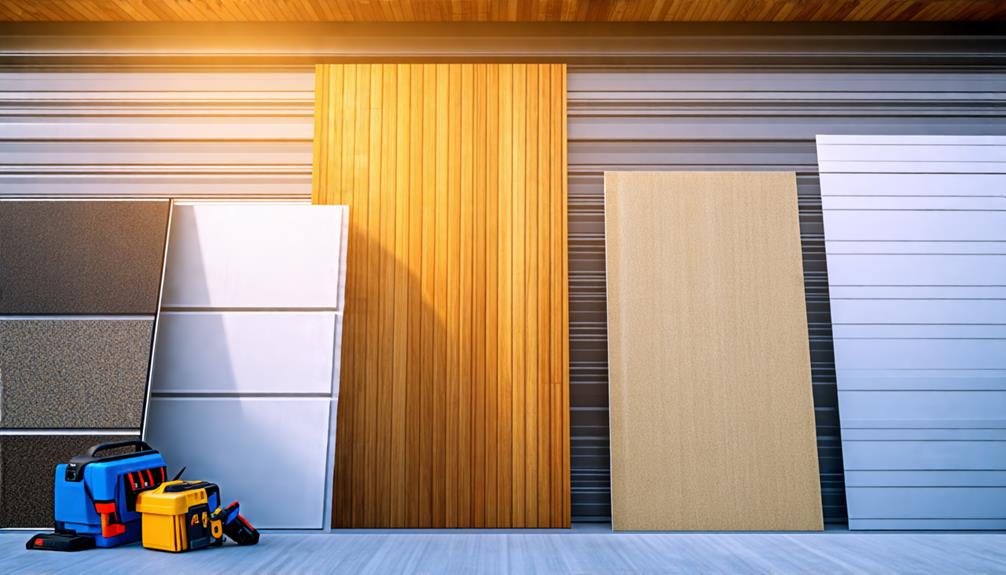
How Do You Prepare for a Garage Door Installation?
To prepare for a garage door installation, start by accurately measuring your garage opening's width, height, and depth. Clear the area of any obstructions and inspect the frame for necessary repairs. Guarantee the floor is level and free of debris. Select an appropriate door material, size, and design that complements your home's style and meets energy efficiency needs. Schedule the installation appointment and provide clear access to the work area. Communicate any specific requirements to the installation team. By following these steps, you'll set the stage for a successful garage door upgrade. The process involves more intricate details that can greatly impact the outcome.
Measuring Your Garage Opening

When preparing for a garage door installation, you'll need to take precise measurements of your garage opening. This vital first step will ensure a seamless installation and prevent any future problems with the fit of the door. Our professional team can help guide you through this process for optimal results.
Start by measuring the width at three points—the top, middle, and bottom—to ensure accuracy, as older garages may have settled unevenly. Next, measure the height from the floor to the top of the opening, and don't forget to account for any obstructions like pipes or electrical fixtures that might interfere with the door's operation.
The removal of an old door, if applicable, will also be an essential step in this process. Finally, consider the depth and clearance requirements, measuring from the opening to the nearest obstruction on the ceiling or walls, as this will determine the type of door and opener system you can install.
Accurate Width Measurements
Precision is key when measuring your garage opening for a new door installation. To guarantee accurate width measurements, you'll need to take three separate measurements: at the bottom, middle, and top of the opening. Why three? Because garage openings aren't always perfectly square, and these measurements will help identify any discrepancies.
Start by measuring the width at the bottom of the opening, placing your tape measure on the inside edge of the left jamb and extending it to the inside edge of the right jamb. Record this measurement to the nearest 1/8 inch. Repeat this process at the middle and top of the opening. Are your measurements consistent? If not, don't panic. It's common for older garages to have slight variations. You'll use the smallest of these three measurements when ordering your new door.
Height Considerations
Now that you've measured the width, it's time to focus on the height of your garage opening. Start by measuring from the floor to the highest point of the opening, typically where the header or lintel is located. It's indispensable to take multiple measurements along the height, as the floor mightn't be perfectly level or the header could have slight variations. Record the smallest measurement to guarantee your new door will fit properly.
Consider the headroom, which is the space between the top of the opening and the ceiling or any overhead obstructions. This area is essential for the door's operating mechanism. Standard headroom requirements vary depending on the type of door and lift system you're planning to install. For example, a standard torsion spring system typically needs 12-14 inches of headroom, while a low-headroom system might require as little as 4-6 inches.
Don't forget to measure the sideroom on both sides of the opening. This space is necessary for the vertical tracks and any additional hardware. Generally, you'll need at least 3-4 inches on each side. Finally, consider the backroom, which is the distance from the garage opening to the back wall. This measurement is critical for accommodating the horizontal tracks and ensuring proper door operation.
Depth and Clearance
The garage's depth and clearance play an essential role in guaranteeing your new door will operate smoothly. You'll need to measure the depth of your garage from the opening to the back wall, as well as the headroom (vertical space) above the opening.
For most standard sectional doors, you'll need at least 12 inches of headroom, but low-headroom tracks can accommodate as little as 7 inches. Don't forget to account for any obstructions like pipes, electrical boxes, or support beams.
Next, measure the side room on both sides of the opening. You'll typically need 3.75 inches on each side for the vertical tracks. If you're considering an automatic opener, factor in additional space for the motor unit and rails.
What about the backroom? This is the distance from the opening to the rear garage wall or any obstruction. For a 7-foot-high door, you'll need about 14 feet of backroom.
How will you maintain proper ventilation? Consider installing vents or windows to maintain air circulation. Remember, precise measurements are pivotal. Have you accounted for the door's thickness when fully open? Double-check all measurements to avoid costly mistakes during installation.
Benefits

When you install a new garage door, particularly with the help of experienced professionals like Future Garage Door, you'll reap numerous benefits that extend beyond mere functionality.
With their assistance, you can get all-encompassing garage door solutions that cater to your specific needs. You can expect improved home security through modern locking mechanisms and sturdy materials, as well as enhanced curb appeal that can greatly boost your property's value.
Additionally, many new garage door models offer superior energy efficiency, helping to regulate your garage's temperature and potentially reduce your energy bills.
Improved Home Security
Installing a new garage door substantially boosts your home's security. Modern garage doors come equipped with advanced locking mechanisms and robust materials that are significantly more difficult for intruders to breach. You'll find that many new models feature rolling code technology, which changes the access code each time you use your remote, preventing code-grabbing devices from gaining unauthorized entry.
Additionally, smart garage door openers allow you to monitor and control your door remotely, enabling you to check its status and close it from anywhere using your smartphone.
When selecting a new garage door, consider options with impact-resistant panels and reinforced tracks. These features not only deter break-ins but also provide enhanced protection against severe weather conditions. You might also opt for a door with windows placed high enough to prevent potential intruders from peering inside while still allowing natural light to enter.
Have you thought about integrating your new garage door with your home security system? This interconnectivity can provide real-time alerts and seamlessly incorporate your garage into your overall home protection strategy, giving you greater peace of mind and extensive security coverage.
Enhanced Curb Appeal
Beyond security improvements, a new garage door can dramatically enhance your home's curb appeal. As one of the largest exterior features, your garage door plays a significant role in your property's overall aesthetic. When selecting a new door, consider styles that complement your home's architecture and color scheme.
Modern designs, such as sleek aluminum or glass panels, can give your house a contemporary edge, while carriage-style doors add a touch of classic elegance to traditional homes.
You'll find a wide array of materials available, including wood, steel, and composite options, each offering unique benefits with regard to durability and visual appeal. Have you thought about incorporating windows into your garage door design? These can add natural light to your garage's interior while creating an attractive focal point from the street. Additionally, customizable hardware, such as decorative handles and hinges, can provide the finishing touches that elevate your door's appearance.
Increased Property Value
A garage door upgrade can markedly boost your home's market value. When you're considering selling your property, this improvement can offer a significant return on investment. Real estate experts often cite garage door replacements as one of the most cost-effective home upgrades, with potential returns reaching up to 94% of the project cost.
Why does a new garage door have such a substantial impact? To begin with, it enhances your home's curb appeal, creating a positive first impression for potential buyers. Moreover, modern garage doors often come with improved insulation properties, which can lead to better energy efficiency for the entire home. This feature is increasingly important to environmentally conscious buyers and those looking to reduce utility costs.
Additionally, newer models typically incorporate advanced security features, such as smart technology integration and robust locking mechanisms. These upgrades not only protect your vehicle and belongings but also contribute to the overall safety of your property. When you invest in a high-quality garage door, you're not just improving aesthetics; you're adding tangible value that appraisers and potential buyers will recognize and appreciate during the home valuation process.
Better Energy Efficiency
One of the most significant benefits of a new garage door installation is improved energy efficiency. When you replace your old, poorly insulated garage door with a modern, energy-efficient model, you'll notice a substantial difference in temperature control and energy consumption. These new doors are designed with advanced insulation materials and weatherstripping, which create a tighter seal and minimize air leakage.
Have you considered how this improved insulation affects your home's overall energy performance? A well-insulated garage door acts as a barrier against extreme temperatures, reducing the workload on your HVAC system. This is particularly important if your garage is attached to your home or if you have living spaces above it. By maintaining a more consistent temperature in your garage, you'll prevent heat transfer to adjacent areas, potentially lowering your energy bills.
Moreover, many modern garage doors come with options for double or triple-layer construction, further enhancing their insulating properties. You can also choose doors with higher R-values, which indicate superior thermal resistance. Remember, investing in an energy-efficient garage door isn't just about immediate comfort; it's a long-term strategy for reducing your carbon footprint and saving on energy costs.
Choosing Garage Door Materials

When choosing garage door materials, you'll need to weigh several factors to make the best decision for your home. Consider the pros and cons of wood versus steel options, keeping in mind aspects like durability, maintenance, and cost. Don't forget to factor in insulation and energy efficiency, as well as style and aesthetic considerations that complement your home's architecture.
| Material | Pros | Cons |
|---|---|---|
| Wood | Natural beauty, customizable | Higher maintenance, less insulation |
| Steel | Durable, low maintenance | Can dent, may rust over time |
| Aluminum | Lightweight, corrosion-resistant | Less secure, limited insulation |
Wood Vs. Steel Options
Deciding between wood and steel garage doors can greatly impact your home's aesthetic and functionality. Wood doors offer a traditional, warm appearance that's highly customizable. You'll find options ranging from affordable pine to luxurious mahogany, each with unique grain patterns.
However, wood requires regular maintenance, including painting or staining, to prevent warping and rotting.
Steel doors, on the other hand, provide durability and low maintenance. They're resistant to warping, cracking, and rotting, making them ideal for harsh climates. Steel doors come in various styles and can be insulated for improved energy efficiency.
While they may lack the natural beauty of wood, modern steel doors can be embossed with wood-grain patterns and painted to mimic the look of timber.
When choosing between wood and steel, consider your budget, climate, and desired aesthetic. Wood doors typically cost more upfront and over time due to maintenance needs. Are you willing to invest time in upkeep for a classic look? Or do you prefer the practicality of steel? Weighing these factors will help you select the best option for your home.
Insulation and Energy Efficiency
Beyond aesthetics and durability, insulation and energy efficiency play a vital role in choosing your garage door material. When selecting a garage door, you'll want to ponder its R-value, which measures thermal resistance. The higher the R-value, the better insulated your garage will be. Steel doors with polyurethane foam insulation typically offer the uppermost R-values, often ranging from R-12 to R-18. In contrast, wood doors generally provide less insulation, with R-values around R-4 to R-6.
Why does this matter? An well-insulated garage door can drastically reduce heat transfer, helping to maintain a more consistent temperature in your garage and adjacent living spaces. This can lead to lower energy bills and increased comfort. Additionally, if you're planning to use your garage as a workshop or living area, proper insulation becomes even more indispensable.
When evaluating insulation options, consider the door's construction. Double-layer and triple-layer doors offer superior insulation compared to single-layer alternatives. Don't forget to examine weatherstripping and bottom seals, which prevent drafts and further enhance energy efficiency. By prioritizing insulation and energy efficiency in your garage door selection, you'll be making a smart, long-term investment in your home's comfort and value.
Style and Aesthetic Considerations
Style and aesthetics play a critical role in choosing your garage door material. Consider the architectural style of your home and select a garage door that complements its design. For instance, if you have a modern house, you might opt for a sleek, aluminum door with large glass panels. Conversely, a traditional home could benefit from a classic wooden door with raised panels. Don't forget to factor in your neighborhood's overall aesthetic to guarantee your choice doesn't clash with the surrounding properties.
When evaluating garage door materials for style, consider these key factors:
- Texture: Does the material offer smooth, wood-grain, or stucco-like finishes?
- Color options: Are there pre-finished choices, or will you need to paint the door yourself?
- Decorative elements: Can you add windows, hardware, or other embellishments to enhance the door's appearance?
Frequently Asked Questions
How Long Does a Typical Garage Door Installation Take?
You can expect a typical garage door installation to take between 3 to 6 hours. The exact time depends on factors like the door's complexity, size, and any additional features. It's best to set aside a full day for the process.
Do I Need to Obtain a Permit for Garage Door Installation?
You'll typically need a permit for garage door installation, but it depends on your local regulations. Check with your city's building department to confirm requirements. Don't skip this step, as unpermitted work can lead to fines or complications.
Can I Install a Garage Door Opener at the Same Time?
Yes, you can install a garage door opener simultaneously with your new garage door. It's often more efficient to do both at once. You'll save time and guarantee compatibility between the door and opener system.
What Maintenance Is Required After Installation?
After installation, you'll need to regularly lubricate moving parts, tighten hardware, and inspect springs and cables. You should also test the safety features, clean the tracks, and adjust the balance. Don't forget to schedule professional maintenance annually.
How Much Does Professional Garage Door Installation Typically Cost?
You'll typically spend between $500 and $2,000 for professional garage door installation. Costs vary based on door type, material, and size. Additional features like openers or custom designs can increase the price. Always get multiple quotes for comparison.





